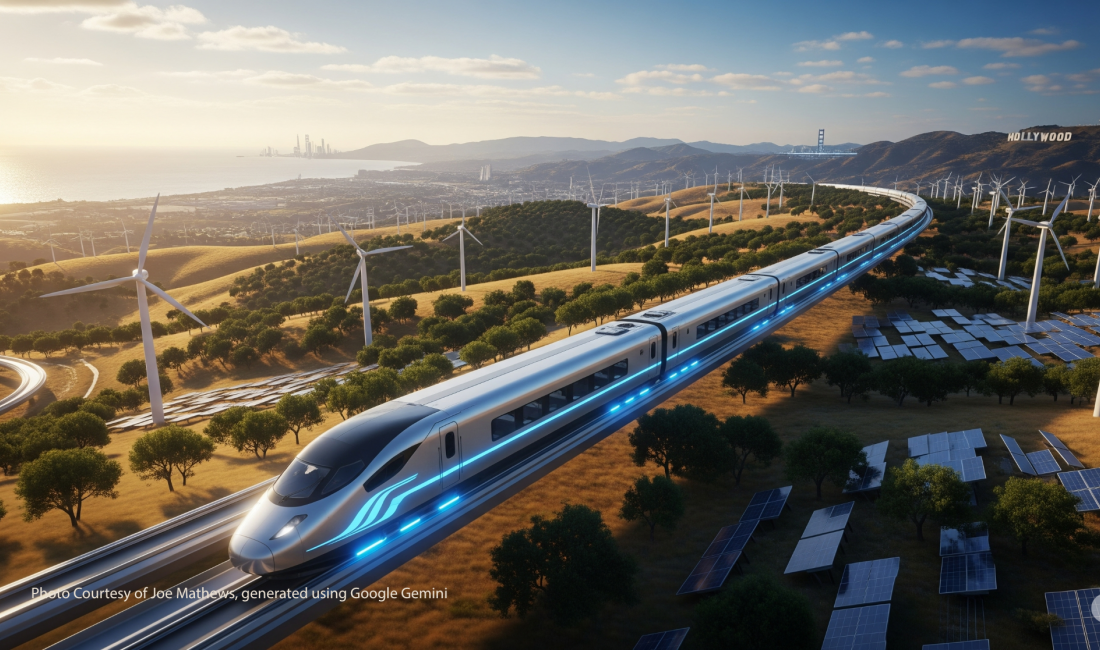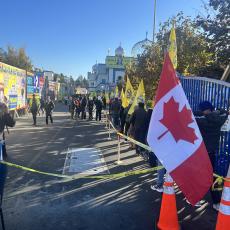Trump, by Trying to Kill a Project, May Save It
Co-published with Zócalo Public Square.
Donald Trump just gave Californians a new opening to save our high-speed rail project.
Will we take it?
Of course, Trump, true to form, offered us this opportunity in a nasty, illegal way. He had the Federal Railroad Administration claw back $4 billion in money previously dedicated to construction, and declared that he had killed a “train to nowhere.”
Yes, I realize that removing billions from a famously underfunded project wouldn’t normally be expected to boost high-speed rail. But we don’t live in a normal time or in a normal country. In our polarized era, many of us are motivated to act on something just because our enemies hate the idea.
So, when Trump declares he is killing something, he is really offering a neo-fascist version of the biblical mark of Cain—a punishment that also confers a sort of superpower. In the fourth chapter of Genesis, God banishes Cain for murdering his brother Abel, but also places a “mark” of protection on Cain so that no one who encounters him in his wanderings will kill him.
Getting attacked by Trump seems to deliver a similar protective mark and even a new lease on life. After the president used his “Big Beautiful Bill” to make massive cuts to Medicaid, the health program for the poor surged in popularity. When Trump blasted Europe’s progressive social policies and trade policies, more Americans sought to move there. And Trump’s lawless immigration raids, which snatch undocumented people and U.S. citizens alike off the streets, inspired dramatic changes in public support for immigrants. The percentage of Americans who want immigration to decrease dropped by 25 points this year, and a record-high 79% of Americans now call immigration a “good thing” for the country.
Now, Trump’s mark is starting to work its magic on high-speed rail. After nearly two decades of indifferent pursuit of the project, the state’s leaders are rallying to defend it.
A day after Trump’s claw-back, California Attorney General Rob Bonta filed a lawsuit demanding all $4 billion returned, arguing that the president’s decision was illegal and based on falsehoods. Gov. Gavin Newsom, who has long expressed skepticism about the mega-project, now rallies behind it, calling it a vital part of his plans. Legislative Democrats have closed ranks behind high-speed rail with new force. And the High-Speed Rail Authority, long cautious politically, has gone to war, with its CEO Ian Choudri blasting the Trump administration.
Such shows of support are, put simply, unprecedented. While California Republicans have been most outspoken in criticizing high-speed rail, the state’s Democratic establishment has been its real opposition.
That’s because high-speed rail wasn’t a Democratic idea or a priority. Future-minded governor Jerry Brown championed rail during his first term in the 1970s, but got nowhere. Approval for the project came instead from California voters in 2008, thanks to a ballot initiative campaign led by the independent state lawmaker Quentin Kopp, who is unpopular with Democrats.
Since then, California Democrats have often quietly registered support for the project in public while seeking to undermine it in private. Democratic legislators don’t like building things, especially expensive infrastructure. They prefer to send public dollars to labor interests that fund their campaigns, and to social programs that directly support Californians who might vote for them.
In recent years, legislative leaders have sought to repurpose high-speed rail funds for local and regional projects, especially in Southern California, which has been left out of the first phase of high-speed rail construction. Then, in 2019, Newsom used his state of the state speech to criticize the program and shrink its starting construction footprint to a 171-mile stretch of the Central Valley, connecting Merced and Bakersfield.
The speech made it sound like Newsom was abandoning high-speed rail, and the first Trump administration followed up by withholding hundreds of millions for the project. Subsequent headlines (and even columnists) suggested the project was dead.
But facing death, high-speed rail has made real progress in the current decade.
Construction on the first phase, in the Central Valley, has produced more than 50 new structures (think bridges and viaducts) for the rail projects. Officials completed environmental reviews on the 463 miles from L.A. to San Jose. Caltrain electrified its Bay Area corridor, a prerequisite for expanding high-speed rail service there. And earlier this year, crews began the process of laying train tracks, with the railhead groundbreaking at Bakersfield.
Trump’s current attack on the project only highlights this progress. As the president lies about money wasted on nothing, California can respond with photos of all that has been built and is being built. The state also stands a good chance of winning back the $4 billion in court—the money is already obligated under legally binding agreements, and the project passed federal reviews as recently as February. And public support for high-speed rail has long been higher than the project’s bad press suggests.
Politically, Trump’s attack is an enormous gift. Backers of the project, long a punching bag for populists, now have their own populist target: the dictatorial president who is trying to cancel America’s only public high-speed rail, which Californians approved at the polls.
Already, state officials are putting Trump on the defensive. They say Trump is providing a gift to China, which has built the world’s most robust high-speed rail network. They note that he’s hurting his own Central Valley voters, by canceling a construction project that produced 15,000-plus jobs in more conservative inland counties. They remind Californians that he’s basing his decision to pull billions from high-speed rail based on lies and personal animus toward a state that didn’t vote for him.
“Trump’s termination of federal grants for California high-speed rail reeks of politics,” Newsom said after the cancellation. “It’s yet another political stunt to punish California.”
But Trumpian punishment also opens new possibilities. With the incompetent and corrupt federal administration no longer involved in the project, private investors might be willing to jump in. In recent weeks, the state has been discussing a $1 billion annual investment in high-speed rail, with the goal of forging private-public partnerships.
This spring, polls showed majority support for high-speed rail among Californians, with voter approval as high as 67%—twice Trump’s approval rating in the state.
Make this a contest between fast new trains and an aging autocrat, and California wins.




